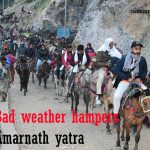Few religious pilgrimages worldwide generate the kind of adventure, security concerns, and political symbolism as the amarnath yatra 2023 to the Cave Shrine of the Hindu deity Shiva in the Himalayas.

His year’s two-month event is underway with full power and spectacle. Take a look The chant to Lord Shiva as the first batch of pilgrims begin a 48-kilometre trek to the cave Shrine from Pahalgam This is one of two designated starting camps for the trek. Over three to five days of trudging uphill, besides an intensely scenic route, they’ll see elaborate State arrangements.
Intense Indian army security cordons and plenty of adventure are progressing very smoothly, although for those who choose to travel on foot to face certain challenges, the blessing of Bhole Baba at the Journey’s End makes it worthwhile.
I would like to request all the devotees who are in good health to undertake the pilgrimage on foot rather than using horses, as Bhole Baba beckons you to walk.
The pilgrimage opens once a year over 62 days in July and August, covering the Shravan month of the Hindu calendar. Beyond the religious order, physical and mental Fitness are key.
The two roots, one starting from Balthal to Sangam and onto the Amarnath Cave, a distance of 14 kilometres in all. It is shorter, taking one or two days, but is more difficult to cover terrain-wise.
The second, more popular one, is the one from Pehlgam via Chandanwari to Sangam and Amarnath. This one is 36 to 48 kilometres long and takes three to five days, but it’s easier and more convenient for most.
The root challenge is just one aspect of what makes the Amarat Yatra stand out as a Hindu pilgrimage in a Muslim majority region: the politics around the Kashmir issue and the Kashmiri identity security of the pilgrims against the backdrop of attacks and accidents frequently take centre stage.
The India-Pakistan dimension and the Kashmir dispute add to the security threat cloud; there’s huge Prestige at stake.
The Indian army monitors the pilgrimage routes 24 hours a day, 7 days a week. A multi-level security grid has anti-drone teams and bomb squads, on-alert quadcopters, and night vision devices in place for every trekker.
Pilgrim has a radio frequency ID for tracking, and there’s also the weather. Factor mountain and Avalanche rescue teams are in place after a series of mock drills.
There was a cloud burst and flash flooding. During the yantra last year, emergency helipads were ready to evacuate pilgrims in case of any emergency.
100 Bed-base hospitals have been set up at Baltal and Chandanvari. The Indian army, Jammu Kashmir police, and paramilitary forces have a busy two months ahead.
Even until 1989, when Kashmir became the flashpoint, the Amarnath pilgrimage used to be a low-key event. Security mobilisation, the minority-majority debate, and political Prestige are at stake.
Now give the Amarnath Yatra New Dimensions. More than a pilgrimage, there are larger Stakes at work here.










